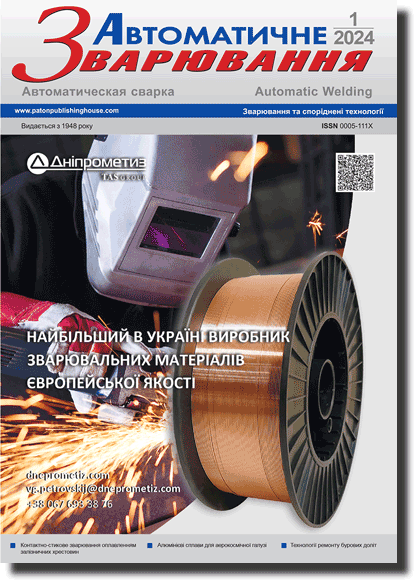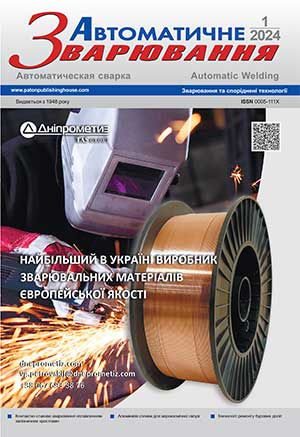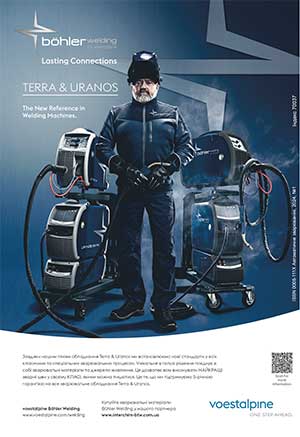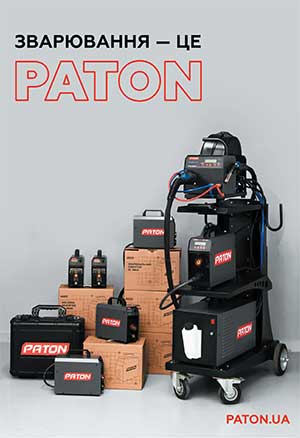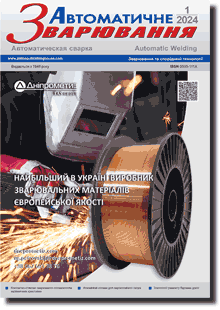
Avtomaticheskaya Svarka (Automatic Welding), #1, 2024, pp. 9-14
2Jiangsu University of Science and Technology, No. 666, Changhui Road, Dantu District, Zhenjiang, Jiangsu, China
The paper studies the effect of arc welding technological processes on the resistance of welded joints of scarcely alloyed atmosphere-resistant 06G2BDP steel to cold and hot cracks formation and brittle and fatigue fracture. With the help of the Implant method and using the technological Tekken sample, the conditions for cold cracks formation were evaluated and the methods of their elimination were recommended. It is shown that with the use of mechanized welding in shielding gases, solidsection and flux-cored wires provide high technological strength of welded joints in terms of hot cracks formation in a wide range of welding modes. On the other hand, when using coated electrodes, this range is narrowed, and at Vdef ≥ 20 mm/min, joints are prone to the formation of this defect. The results of studies on the evaluation of welded joints resistance to brittle fracture indicate high values of the stress intensity factor KQ for both the weld metal and HAZ metal. The endurance limit of T-joints when tested by cyclic loading was determined, which is [ σ ]-1 = 35 MPa. 15 Ref., 1 Tabl., 5 Fig.
Keywords: atmosphere-resistant steel, welded joints, cold cracks, hot cracks, brittle fracture, cyclic loading, fatigue fracture
Received: 13.11.2023
Received in revised form: 01.12.2023
Accepted: 25.12.2023
2. Poznyakov, V.D., Zhdanov, S.L., Maksimenko, A.A. et al. (2013) Weldability of sparcely-alloyed steels 06GBD, 06G2B. The Paton Welding J., 4, 8-14.
3. Zavdoveev, A.V., Poznyakov, V.D., Zhdanov, S.L. et al. (2020) Impact of thermal cycles of welding on formation of the structure and properties of corrosion-resistant steel 06G2BDP. The Paton Welding J., 9, 22-27. https://doi.org/10.37434/as2020.09.02
4. Morcillo, M., Díaz, I., Cano, H. et al. (2019) Atmospheric corrosion of weathering steels. Over view for engineers. Pt II: Testing, inspection, maintenance. Construction and Building Materials, 222, 750-765. https://doi.org/10.1016/j.conbuildmat.2019.06.155
5. Miki, C., Homma, K., Tominaga, T. (2002) High strength and high performance steels and their use in bridge structures. J. of Constructional Steel Research, 58(1), 3-20. https://doi.org/10.1016/S0143-974X(01)00028-1
6. Bjorhovde, R. (2004) Development and use of high performance steel. J. of Constructional Steel Research, 60 (3-5), 393-400. https://doi.org/10.1016/S0143-974X(03)00118-4
7. Albrecht, P., HallJr, T.T. (2003) Atmospheric corrosion resistance of structural steels. J. of Materials in Civil Engineering, 15(1), 2-24. https://doi.org/10.1061/(ASCE)0899-1561(2003)15:1(2)
8. Berdnikova, O.M., Poznyakov, V.D., Kostin, V.A. et al. (2021) Structure and fracture mode of HAZ metal corrosion- resistant 06G2BDP steel. Suchasna Elektrometal., 3, 35-41 [in Ukrainian]. https://doi.org/10.37434/sem2021.03.06
9. Zhdanov, S.L., Poznyakov, V.D., Zavdoveyev, A.V., et al. (2023) Structure and properties of welded joints of 06G2BDP steel. The Paton Welding J., 9, 11-16. https://doi.org/10.37434/tpwj2023.09.02
10. Sterenbogen, Yu.A. (1986) Some factors determining the resistance of HAZ metal of martensitic steels to cold cracking. Avtomatich. Svarka, 6, 5-8 [in Russian].
11. Poznyakov, V.D. (2023) Welding technologies for repair of metal structures. Kyiv, PWI [in Ukrainian].
12. Hrivnak, I. (1984) Weldability of steels. Moscow, Mashinostroenie [in Russian].
13. Lobanov, L.M., Poznyakov, V.D., Mikhoduj, O.L. (2004) Effect of residual stresses on technological strength of welded joints of high-strength steel 14KhGN2MDAFB. The Paton Welding J., 8, 30-34.
14. Tsaryuk, A.K., Skulsky, V.Yu., Nimko, M.A. et al. (2016) Improvement of the technology of welding high-temperature diaphragms in steam turbine flow section. The Paton Welding J. 3, 28-36. https://doi.org/10.15407/tpwj2016.03.05
15. Trufyakov, V.I. (1973) Fatigue of welded joints. Kyiv, Naukova Dumka [in Russian].
Influence of arc welding technology on resistance of welded joints of 06G2BDP steel to cold and hot cracks formation, fatigue and brittle fracture
Automatic Welding №01 2024 p.9-14
The cost of article: 150 UAH,16 $,15 €. (one article)
AS = «Automatic Welding» - 6 issues per year;
TPWJ = «PATON WELDING JOURNAL» - 12 issues per year;
SEM = «Electrometallurgy Today» - 4 issues per year;
TDNK = «Technical Diagnostics and Non-Destructive Testing» - 4 issues per year.
| 2024 №01 (08) |
DOI of Article 10.37434/as2024.01.01 |
2024 №01 (02) |

Avtomaticheskaya Svarka (Automatic Welding), #1, 2024, pp. 9-14
Influence of arc welding technology on resistance of welded joints of 06G2BDP steel to cold and hot cracks formation, fatigue and brittle fracture
O.A. Haivoronskyi1, V.D. Poznyakov1, S.L. Zhdanov1, A.M. Gerasymenko1, V.D. Ryabokon1, A.O. Maksymenko1, Jianxin Wang2
1E.O. Paton Electric Welding Institute of the NAS of Ukraine 11 Kazymyr Malevych Str., 03150, Kyiv, Ukraine. E-mail: office@paton.kiev.ua2Jiangsu University of Science and Technology, No. 666, Changhui Road, Dantu District, Zhenjiang, Jiangsu, China
The paper studies the effect of arc welding technological processes on the resistance of welded joints of scarcely alloyed atmosphere-resistant 06G2BDP steel to cold and hot cracks formation and brittle and fatigue fracture. With the help of the Implant method and using the technological Tekken sample, the conditions for cold cracks formation were evaluated and the methods of their elimination were recommended. It is shown that with the use of mechanized welding in shielding gases, solidsection and flux-cored wires provide high technological strength of welded joints in terms of hot cracks formation in a wide range of welding modes. On the other hand, when using coated electrodes, this range is narrowed, and at Vdef ≥ 20 mm/min, joints are prone to the formation of this defect. The results of studies on the evaluation of welded joints resistance to brittle fracture indicate high values of the stress intensity factor KQ for both the weld metal and HAZ metal. The endurance limit of T-joints when tested by cyclic loading was determined, which is [ σ ]-1 = 35 MPa. 15 Ref., 1 Tabl., 5 Fig.
Keywords: atmosphere-resistant steel, welded joints, cold cracks, hot cracks, brittle fracture, cyclic loading, fatigue fracture
Received: 13.11.2023
Received in revised form: 01.12.2023
Accepted: 25.12.2023
References
1. Kovtunenko, V.A., Gerasimenko, A.M., Gotsulyak, A.A. (2006) Selection of steel for critical building welded structures. The Paton Welding J., 11, 27-31.2. Poznyakov, V.D., Zhdanov, S.L., Maksimenko, A.A. et al. (2013) Weldability of sparcely-alloyed steels 06GBD, 06G2B. The Paton Welding J., 4, 8-14.
3. Zavdoveev, A.V., Poznyakov, V.D., Zhdanov, S.L. et al. (2020) Impact of thermal cycles of welding on formation of the structure and properties of corrosion-resistant steel 06G2BDP. The Paton Welding J., 9, 22-27. https://doi.org/10.37434/as2020.09.02
4. Morcillo, M., Díaz, I., Cano, H. et al. (2019) Atmospheric corrosion of weathering steels. Over view for engineers. Pt II: Testing, inspection, maintenance. Construction and Building Materials, 222, 750-765. https://doi.org/10.1016/j.conbuildmat.2019.06.155
5. Miki, C., Homma, K., Tominaga, T. (2002) High strength and high performance steels and their use in bridge structures. J. of Constructional Steel Research, 58(1), 3-20. https://doi.org/10.1016/S0143-974X(01)00028-1
6. Bjorhovde, R. (2004) Development and use of high performance steel. J. of Constructional Steel Research, 60 (3-5), 393-400. https://doi.org/10.1016/S0143-974X(03)00118-4
7. Albrecht, P., HallJr, T.T. (2003) Atmospheric corrosion resistance of structural steels. J. of Materials in Civil Engineering, 15(1), 2-24. https://doi.org/10.1061/(ASCE)0899-1561(2003)15:1(2)
8. Berdnikova, O.M., Poznyakov, V.D., Kostin, V.A. et al. (2021) Structure and fracture mode of HAZ metal corrosion- resistant 06G2BDP steel. Suchasna Elektrometal., 3, 35-41 [in Ukrainian]. https://doi.org/10.37434/sem2021.03.06
9. Zhdanov, S.L., Poznyakov, V.D., Zavdoveyev, A.V., et al. (2023) Structure and properties of welded joints of 06G2BDP steel. The Paton Welding J., 9, 11-16. https://doi.org/10.37434/tpwj2023.09.02
10. Sterenbogen, Yu.A. (1986) Some factors determining the resistance of HAZ metal of martensitic steels to cold cracking. Avtomatich. Svarka, 6, 5-8 [in Russian].
11. Poznyakov, V.D. (2023) Welding technologies for repair of metal structures. Kyiv, PWI [in Ukrainian].
12. Hrivnak, I. (1984) Weldability of steels. Moscow, Mashinostroenie [in Russian].
13. Lobanov, L.M., Poznyakov, V.D., Mikhoduj, O.L. (2004) Effect of residual stresses on technological strength of welded joints of high-strength steel 14KhGN2MDAFB. The Paton Welding J., 8, 30-34.
14. Tsaryuk, A.K., Skulsky, V.Yu., Nimko, M.A. et al. (2016) Improvement of the technology of welding high-temperature diaphragms in steam turbine flow section. The Paton Welding J. 3, 28-36. https://doi.org/10.15407/tpwj2016.03.05
15. Trufyakov, V.I. (1973) Fatigue of welded joints. Kyiv, Naukova Dumka [in Russian].
Advertising in this issue:
To order the electronic version of the paper:
O.A. Haivoronskyi, V.D. Poznyakov, S.L. Zhdanov, A.M. Gerasymenko, V.D. Ryabokon, A.O. Maksymenko, Jianxin WangInfluence of arc welding technology on resistance of welded joints of 06G2BDP steel to cold and hot cracks formation, fatigue and brittle fracture
Automatic Welding №01 2024 p.9-14
The cost of article: 150 UAH,16 $,15 €. (one article)
fill in the form below:
The cost of subscription/purchase order journals or individual articles
| Journal/Currency | Annual Set | 1 issue printed |
1 issue |
one article |
| AS/UAH | 1800 UAH | 300 UAH | 300 UAH | 150 UAH |
| AS/USD | 192 $ | 32 $ | 26 $ | 16 $ |
| AS/EUR | 180 € | 30 € | 25 € | 15 € |
| TPWJ/UAH | 7200 UAH | 600 UAH | 600 UAH | 280 UAH |
| TPWJ/USD | 384 $ | 32 $ | 26 $ | 16 $ |
| TPWJ/EUR | 360 € | 30 € | 25 € | 15 € |
| SEM/UAH | 1200 UAH | 300 UAH | 300 UAH | 150 UAH |
| SEM/USD | 128 $ | 32 $ | 26 $ | 16 $ |
| SEM/EUR | 120 € | 30 € | 25 € | 15 € |
| TDNK/UAH | 1200 UAH | 300 UAH | 300 UAH | 150 UAH |
| TDNK/USD | 128 $ | 32 $ | 26 $ | 16 $ |
| TDNK/EUR | 120 € | 30 € | 25 € | 15 € |
AS = «Automatic Welding» - 6 issues per year;
TPWJ = «PATON WELDING JOURNAL» - 12 issues per year;
SEM = «Electrometallurgy Today» - 4 issues per year;
TDNK = «Technical Diagnostics and Non-Destructive Testing» - 4 issues per year.





